Table of Contents
- Understanding Your Kitten’s Hair Type
- Choosing the Right Brush for Your Kitten
- Preparing Your Kitten for a Brushing Session
- Proper Brushing Techniques for Short-Haired Kittens
- Proper Brushing Techniques for Long-Haired Kittens
- Dealing with Tangles and Mats
- Avoiding Common Brushing Mistakes
- Brushing Your Kitten’s Sensitive Areas Safely
- Making Brushing Time a Positive Experience for Your Kitten
- Maintaining Your Kitten’s Healthy Coat with Regular Brushing
Understanding Your Kitten’s Hair Type
When it comes to brushing your kitten’s hair, it’s essential to understand their hair type. Kittens can have short, medium, or long hair, and their hair can also vary in texture. By knowing your kitten’s hair type, you can choose the right brush and understand how to properly care for their coat.
Different Hair Types
There are three different types of hair length in kittens: short, medium, and long. Short-haired kittens have a coat that is less than an inch long and lays flat against their body. Medium-haired kittens have hair that is longer than one inch, and long-haired kittens have hair that is more than two inches long.
Different Hair Textures
Kitten’s hair can also differ in texture, which can impact their grooming needs. Some kittens have straight hair, while others may have curly or wavy hair. Kittens with curly or wavy hair are more prone to tangles and mats, and they may require more frequent grooming sessions.
Understanding Your Kitten’s Specific Hair Type
Each kitten’s hair is unique, and it’s essential to understand your kitten’s specific hair type to provide proper care. Take the time to observe your kitten’s hair and note any particular characteristics. Understanding your kitten’s hair type will allow you to choose the right grooming tools and develop a proper grooming routine that will keep their coat healthy and shiny.
In the next section, we will explore the different types of brushes available and which ones work best for your kitten’s hair type.
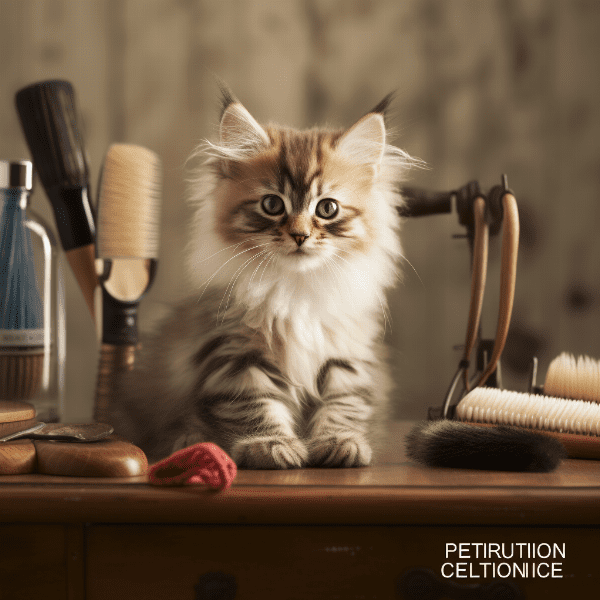
Choosing the Right Brush for Your Kitten
Choosing the right brush is crucial to ensure that you can properly groom your kitten’s hair. Different brushes work best for different types of hair, and using the wrong brush can lead to discomfort and pain for your kitten.
Types of Brushes
There are many different types of brushes available, each with its own unique purpose. Some of the most common types of brushes for kittens include slicker brushes, bristle brushes, and grooming combs.
- Slicker Brushes: These brushes are best for medium to long-haired kittens with thick coats. They have thin, tightly packed wires that can penetrate deep into the coat to remove tangles and mats.
- Bristle Brushes: Bristle brushes work well for short-haired kittens with smooth coats. They have soft, natural bristles that remove loose hair and dirt while distributing natural oils throughout the coat.
- Grooming Combs: Grooming combs are ideal for kittens with curly or wavy hair. They help to remove tangles and mats without pulling or damaging the hair.
Factors to Consider
When choosing a brush for your kitten, there are several factors to consider, including:
- Hair type: Choose a brush that is designed for your kitten’s hair type to ensure effective grooming.
- Size: Select a brush that is appropriate for your kitten’s size, ensuring that it can comfortably reach all areas of their coat.
- Comfort: Look for brushes with comfortable handles to make grooming sessions more comfortable for both you and your kitten.
Experimenting with Different Brushes
It may take some trial and error to find the right brush for your kitten. Don’t be afraid to experiment with different brushes to see what works best for your kitten’s unique hair type. With the right brush, you can ensure that your kitten’s coat remains healthy and shiny.
In the next section, we will explore how to prepare your kitten for a brushing session.
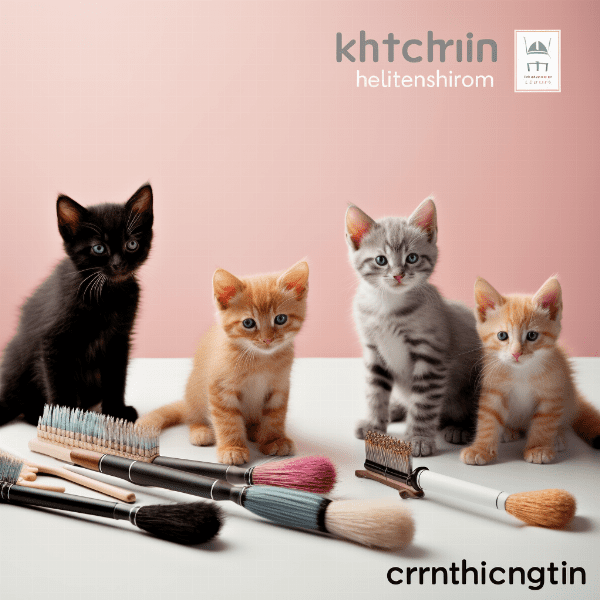
Preparing Your Kitten for a Brushing Session
Before beginning a brushing session with your kitten, it’s essential to prepare them properly. Taking the time to prepare your kitten will help to ensure a positive grooming experience and make the process smoother for both you and your kitten.
Creating a Calm Environment
To prepare your kitten for a brushing session, start by creating a calm environment. Find a quiet, low-traffic area in your home where your kitten can feel relaxed and comfortable. Turn off any loud music or television, and avoid sudden movements or loud noises that could startle your kitten.
Introducing Your Kitten to the Brush
Introduce your kitten to the brush slowly, allowing them to sniff and explore it. This will help them become familiar with the brush and reduce their anxiety during the grooming session.
Using Positive Reinforcement
Positive reinforcement is an effective way to prepare your kitten for a brushing session. Reward your kitten with treats or praise when they allow you to brush them. This will help to create a positive association with brushing and encourage good behavior.
Stopping If Necessary
If your kitten becomes agitated or stressed during the grooming session, stop brushing and give them a break. You can always resume the session later when your kitten is more relaxed.
By taking the time to prepare your kitten for a brushing session, you can help to ensure that the process is comfortable and enjoyable for both you and your kitten. In the next section, we will explore proper brushing techniques for short-haired kittens.
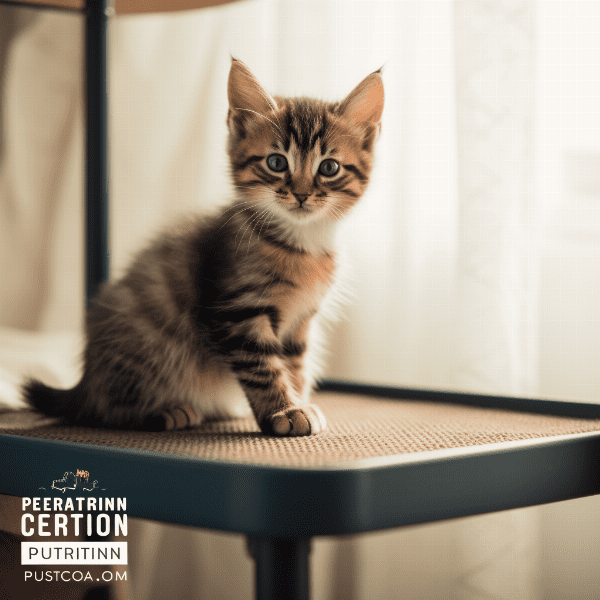
Proper Brushing Techniques for Short-Haired Kittens
Proper brushing techniques are crucial for maintaining your short-haired kitten’s coat health and appearance. Short-haired kittens may require less grooming than long-haired breeds, but regular brushing is still essential to prevent shedding, remove loose hair, and distribute natural oils throughout the coat.
.

Proper Brushing Techniques for Long-Haired Kittens
Long-haired kittens require more grooming than short-haired breeds to prevent tangles, mats, and shedding. Proper brushing techniques are crucial for maintaining your long-haired kitten’s coat health and appearance.
Choosing the Right Brush
Slicker brushes are the best type of brush for long-haired kittens. They have thin, tightly packed wires that can penetrate deep into the coat to remove tangles and mats without damaging the hair.
Brushing Technique
To brush your long-haired kitten, start by gently combing their coat in the direction of hair growth. Use long, smooth strokes, focusing on one section of the coat at a time. Use the slicker brush to remove any tangles or mats, working from the head to the tail.
Paying Attention to Sensitive Areas
Long-haired kittens may have sensitive areas, such as their ears, that may require extra care during the grooming process. Use a light touch in these areas and be careful not to pull or tug on the hair.
Grooming Frequency
Long-haired kittens require frequent grooming to prevent tangles and mats. Aim to groom your long-haired kitten at least once a day, or more frequently during shedding season.
Additional Tips
When grooming your long-haired kitten, you may need to use additional tools, such as scissors or clippers, to trim any excess hair around their paws or ears. Be sure to use these tools carefully and seek professional help if you’re unsure about how to use them safely.
.
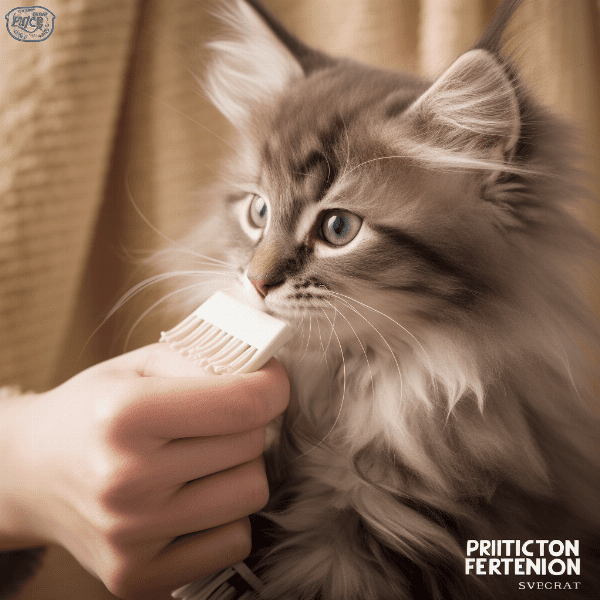
Dealing with Tangles and Mats
Tangles and mats are a common issue in kitten’s coats, especially for long-haired breeds. They can be painful and uncomfortable for your kitten and can lead to skin irritation or infection. Dealing with tangles and mats promptly and properly is crucial for maintaining your kitten’s coat health and appearance.
Identifying Tangles and Mats
Tangles are knots in your kitten’s hair that can be easily separated with a brush or comb. Mats are more severe and occur when hair becomes tangled and knotted tightly together, forming a clump. Mats can be painful and require more effort to remove.
Removing Tangles
To remove tangles, start by gently combing through the tangled area with a comb. Use a detangler spray if needed. Once the hair is separated, use a slicker brush to brush through the area gently.
Removing Mats
Mats require more effort to remove than tangles. Start by using a pair of scissors to cut off the mat as close to the skin as possible. Be careful not to cut your kitten’s skin. Once you have removed the mat, use a comb to gently separate any remaining tangles in the area. Use a slicker brush to brush through the area gently.
Preventing Tangles and Mats
Prevention is key when it comes to tangles and mats. Regular grooming, using the right tools, and paying attention to your kitten’s coat will help prevent tangles and mats from forming. Additionally, keeping your kitten’s hair trimmed and avoiding excessive exposure to water can also help prevent tangles and mats.
.
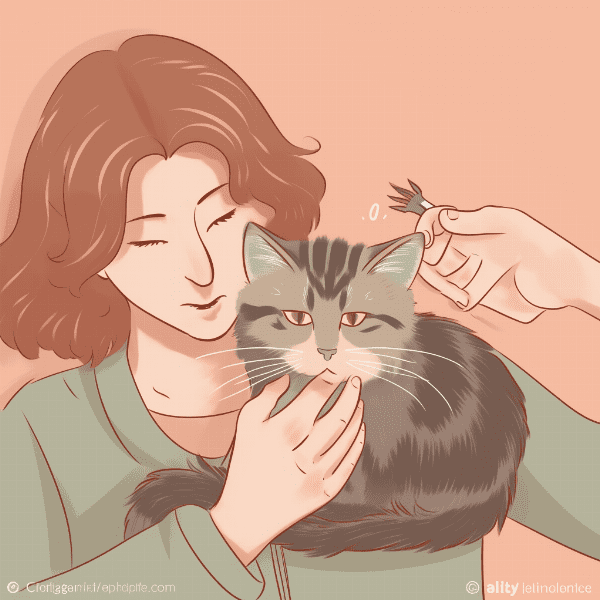
Avoiding Common Brushing Mistakes
Brushing your kitten’s hair is an essential part of their grooming routine, but it’s essential to avoid common mistakes that can cause discomfort, pain, and even injury. By understanding and avoiding these mistakes, you can ensure that your grooming sessions are safe and enjoyable for your kitten.
Brushing Too Hard
Brushing too hard can be painful for your kitten, causing discomfort and even skin irritation. Be sure to use a gentle touch when brushing, especially in sensitive areas.
Using the Wrong Brush
Using the wrong brush can also cause discomfort for your kitten. Be sure to choose a brush that is appropriate for your kitten’s hair type and length.
Brushing Wet Hair
Brushing your kitten’s hair when it’s wet can lead to breakage and damage. Always allow your kitten’s hair to dry fully before brushing.
Neglecting Sensitive Areas
Neglecting sensitive areas, such as the stomach and ears, can cause discomfort and even pain for your kitten. Be sure to pay attention to these areas and use a gentle touch when brushing.
Pulling or Tugging on Tangles
Pulling or tugging on tangles can be painful for your kitten and can cause damage to their coat. Be sure to use a detangler spray and a comb to gently separate tangles before brushing.
Neglecting Regular Grooming
Neglecting regular grooming can lead to tangles, mats, and shedding, making grooming sessions more difficult and uncomfortable for your kitten. Be sure to groom your kitten regularly to keep their coat healthy and shiny.
.
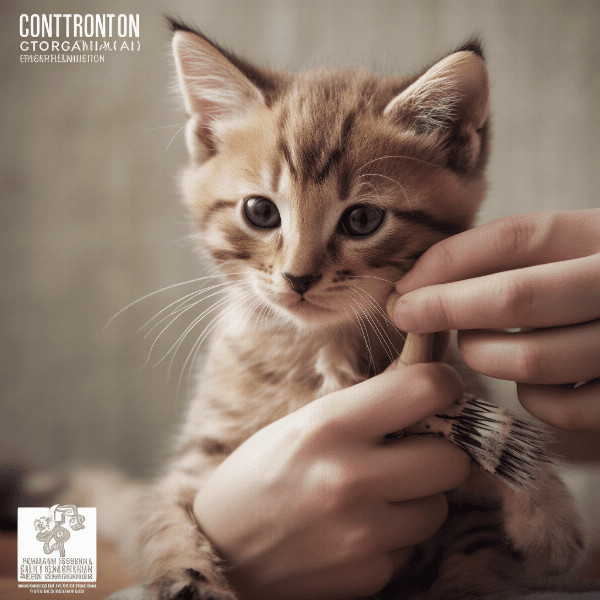
Brushing Your Kitten’s Sensitive Areas Safely
Brushing your kitten’s sensitive areas can be tricky, as these areas may be more prone to tangling and matting. However, with the right tools and techniques, you can safely groom these areas without causing discomfort or injury to your kitten.
Ears
The ears are a sensitive area that requires extra care during grooming. Use a soft-bristled brush or a grooming comb to gently remove any loose hair and dirt from the ears. Avoid using any sharp objects or pulling on the hair around the ears.
Stomach
The stomach is a particularly sensitive area that can be painful for your kitten if brushed too hard. Use a gentle touch when brushing the stomach, and be sure to use a soft-bristled brush or a grooming comb to avoid pulling or tugging on the hair.
Face
The face is a sensitive area that requires special attention during grooming. Use a soft-bristled brush or a grooming comb to remove any loose hair or dirt from the face. Be careful not to get any water or grooming products in your kitten’s eyes, nose, or mouth.
Paws
The paws are another sensitive area that requires extra care during grooming. Use a slicker brush to gently remove any tangles or mats in the hair around the paws, taking care not to pull or tug on the hair.
.
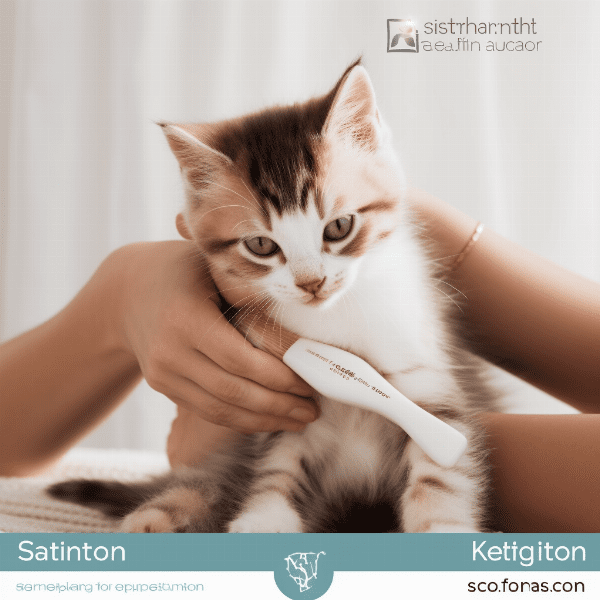
Making Brushing Time a Positive Experience for Your Kitten
Brushing your kitten’s hair can be a bonding experience between you and your furry friend, but it’s important to make it a positive experience for your kitten. By following the tips and techniques outlined in this guide, you can help your kitten feel comfortable and relaxed during grooming sessions.
Establish a Routine
Establishing a regular grooming routine can help your kitten become more comfortable with the process. Aim to groom your kitten at the same time each day or week, and be consistent with your technique and tools.
Use Positive Reinforcement
Positive reinforcement is a powerful tool for making brushing time a positive experience for your kitten. Reward your kitten with treats, praise, or playtime after each grooming session to create a positive association with brushing.
Start Slowly
Start each grooming session slowly, focusing on one area of your kitten’s coat at a time. Use a gentle touch and gradually increase the pressure and intensity as your kitten becomes more comfortable with the process.
Be Patient
Patience is key when it comes to grooming your kitten’s hair. Take breaks if your kitten becomes agitated or stressed, and be prepared to stop if necessary.
Pay Attention to Your Kitten’s Body Language
Your kitten’s body language can tell you a lot about how they’re feeling during grooming sessions. Watch for signs of stress or discomfort, such as flattened ears or twitching tail, and adjust your technique accordingly.
.

Maintaining Your Kitten’s Healthy Coat with Regular Brushing
Regular brushing is essential for maintaining your kitten’s coat health and appearance. By following a consistent grooming routine and using the proper techniques, you can help your kitten’s coat look and feel its best.
Benefits of Regular Brushing
Regular brushing has many benefits for your kitten’s coat health, including:
- Removing loose hair and preventing shedding
- Preventing tangles and mats
- Distributing natural oils throughout the coat for a shiny appearance
- Promoting healthy skin by removing dirt and debris
How Often to Brush
The frequency of brushing your kitten’s coat will depend on their hair type and length. Short-haired kittens may require brushing once a week, while long-haired breeds may require daily grooming. Pay attention to your kitten’s coat and adjust your grooming routine as necessary.
Tools Needed
To maintain your kitten’s healthy coat, you will need the right tools, including:
- Slicker brush for removing tangles and mats
- Comb for detangling and smoothing
- Scissors for trimming excess hair
- Detangler spray for stubborn tangles
Grooming Technique
To maintain your kitten’s healthy coat, start by choosing the right brush for their hair type. Use gentle strokes and focus on one area of the coat at a time. Be sure to pay attention to sensitive areas, and use a detangler spray and comb to remove any tangles.
Wrap Up
Maintaining your kitten’s healthy coat with regular brushing requires the right tools, techniques, and frequency. By understanding the benefits of regular brushing, how often to brush, the tools needed, and the proper grooming technique, you can help your kitten’s coat look and feel its best. Remember to also make brushing time a positive experience for your kitten with patience, positive reinforcement, and attention to their body language.




